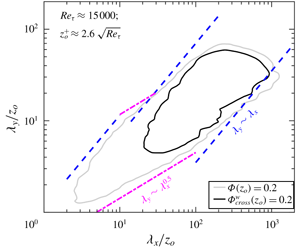Article contents
Two-dimensional cross-spectrum of the streamwise velocity in turbulent boundary layers
Published online by Cambridge University Press: 02 March 2020
Abstract

In this paper, we present the two-dimensional (2-D) energy cross-spectrum of the streamwise velocity ( $u$) component and use it to test the notion of self-similarity in turbulent boundary layers. The primary focus is on the cross-spectrum (
$u$) component and use it to test the notion of self-similarity in turbulent boundary layers. The primary focus is on the cross-spectrum ( $\unicode[STIX]{x1D6F7}_{cross}^{w}$) measured across the logarithmic (
$\unicode[STIX]{x1D6F7}_{cross}^{w}$) measured across the logarithmic ( $z_{o}$) and near-wall (
$z_{o}$) and near-wall ( $z_{r}$) wall-normal locations, providing the energy distribution across the range of streamwise (
$z_{r}$) wall-normal locations, providing the energy distribution across the range of streamwise ( $\unicode[STIX]{x1D706}_{x}$) and spanwise (
$\unicode[STIX]{x1D706}_{x}$) and spanwise ( $\unicode[STIX]{x1D706}_{y}$) wavelengths (or length scales) that are coherent across the wall-normal distance.
$\unicode[STIX]{x1D706}_{y}$) wavelengths (or length scales) that are coherent across the wall-normal distance.  $\unicode[STIX]{x1D6F7}_{cross}^{w}$ may thus be interpreted as a wall-filtered subset of the full 2-D
$\unicode[STIX]{x1D6F7}_{cross}^{w}$ may thus be interpreted as a wall-filtered subset of the full 2-D  $u$-spectrum (
$u$-spectrum ( $\unicode[STIX]{x1D6F7}$), the latter providing information on all coexisting eddies at
$\unicode[STIX]{x1D6F7}$), the latter providing information on all coexisting eddies at  $z_{o}$. To this end, datasets comprising synchronized two-point
$z_{o}$. To this end, datasets comprising synchronized two-point  $u$-signals at
$u$-signals at  $z_{o}$ and
$z_{o}$ and  $z_{r}$, across the friction Reynolds number range
$z_{r}$, across the friction Reynolds number range  $Re_{\unicode[STIX]{x1D70F}}\sim O(10^{3}){-}O(10^{4})$, are analysed. The published direct numerical simulation (DNS) dataset of Sillero et al. (Phys. Fluids, vol. 26 (10), 2014, 105109) is considered for low-
$Re_{\unicode[STIX]{x1D70F}}\sim O(10^{3}){-}O(10^{4})$, are analysed. The published direct numerical simulation (DNS) dataset of Sillero et al. (Phys. Fluids, vol. 26 (10), 2014, 105109) is considered for low- $Re_{\unicode[STIX]{x1D70F}}$ analysis, while the high-
$Re_{\unicode[STIX]{x1D70F}}$ analysis, while the high- $Re_{\unicode[STIX]{x1D70F}}$ dataset is obtained by conducting synchronous multipoint hot-wire measurements. High-
$Re_{\unicode[STIX]{x1D70F}}$ dataset is obtained by conducting synchronous multipoint hot-wire measurements. High- $Re_{\unicode[STIX]{x1D70F}}$ cross-spectra reveal that the wall-attached large scales follow a
$Re_{\unicode[STIX]{x1D70F}}$ cross-spectra reveal that the wall-attached large scales follow a  $\unicode[STIX]{x1D706}_{y}/z_{o}\sim \unicode[STIX]{x1D706}_{x}/z_{o}$ relationship more closely than seen for
$\unicode[STIX]{x1D706}_{y}/z_{o}\sim \unicode[STIX]{x1D706}_{x}/z_{o}$ relationship more closely than seen for  $\unicode[STIX]{x1D6F7}$, where this self-similar trend is obscured by coexisting scales. The present analysis reaffirms that a self-similar structure, conforming to Townsend’s attached eddy hypothesis, is ingrained in the flow.
$\unicode[STIX]{x1D6F7}$, where this self-similar trend is obscured by coexisting scales. The present analysis reaffirms that a self-similar structure, conforming to Townsend’s attached eddy hypothesis, is ingrained in the flow.
- Type
- JFM Rapids
- Information
- Copyright
- © The Author(s), 2020. Published by Cambridge University Press
References
- 19
- Cited by


